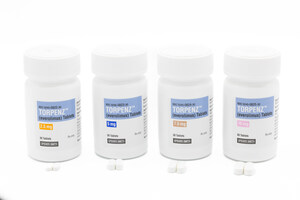Phase I Research of Extended-Release Topiramate Shows Less Fluctuation in Plasma Levels
Upsher-Smith Laboratories, Inc. presents posters at annual American Academy of Neurology (AAN) meeting
MAPLE GROVE, Minn., April 11, 2011 /PRNewswire/ -- Upsher-Smith Laboratories today announced the presentation of data indicating that once daily administration of USL255, a proprietary extended-release (ER) formulation of the epilepsy medication topiramate, was associated with less fluctuation in topiramate plasma levels compared to immediate-release (IR) topiramate administered twice daily in healthy volunteers.
These data were presented Monday, April 11 at the American Academy of Neurology's (AAN) 2011 Annual Meeting in Honolulu, HI, and marked another milestone in Upsher-Smith's commitment to addressing unmet patient needs in epilepsy and other central nervous system diseases.
USL255 is being developed for the treatment of adults with partial-onset seizures and is the subject of a Phase III clinical trial (PREVAIL). This proprietary extended-release formulation is designed to provide convenient once-daily dosing with reduced fluctuation in topiramate plasma levels versus traditional IR dosage forms.
"Fluctuations in plasma levels with certain antiepileptic drugs have the potential to cause challenges for patients with epilepsy. There is concern that some individuals may experience increased side effects during peak concentrations, or suffer break-through seizures if plasma levels fall too low. We are excited to share this Phase I data about USL255 and its encouraging pharmacokinetic profile with clinicians at AAN," said Mark Halvorsen, Pharm.D., Senior Director, Clinical Development at Upsher-Smith.
Abstracts of the poster presentations can be found online at www.aan.com. Titles and authors are:
- "Development and Optimization of Extended-Release Formulations of Topiramate." Authors: Lawrence J. Lambrecht, Wesley M. Todd, John A. Carrithers, Mark B. Halvorsen.
- "Pharmacokinetic Equivalence Between Immediate-Release Topiramate and USL255 (A Novel Extended-Release Formulation of Topiramate) and its Lack of Food-Effect." Authors: Lawrence J. Lambrecht, Wesley M. Todd, Mark B. Halvorsen.
The studies that are the subjects of these posters have been conducted by Upsher-Smith to characterize the pharmacokinetic profile of USL255. The first poster presented data from numerous internally developed topiramate ER formulations. The objective of the research presented was to identify a once daily ER formulation with a lower maximum plasma concentration, a higher trough concentration, and an equivalent extent of exposure as compared to IR topiramate. The PK data from the experimental formulations were compared to IR topiramate, after single doses and/or at simulated steady-state. Results have aided USL researchers in the formulation selection for USL255.
In another study and second poster presentation, the effect of food on the bioavailability of USL255 was assessed. In this Phase I, randomized, single-dose, crossover study, 36 healthy subjects received three different treatments (200 mg of USL255 under fasting conditions; 200 mg of USL255 with a high fat meal; or 2 doses of 100 mg IR topiramate dosed 12 hours apart). Based on PK measurements and using standard bioequivalence criteria, the authors determined that the overall extent of absorption of USL255 was not affected by food. However, the presence of food was associated with a delay in the time to maximal plasma concentration of topiramate, a finding that was deemed consistent with the food effect on IR topiramate pharmacokinetics.
The second poster also compared two 100 mg doses of IR topiramate (administered 12 hours apart) and a single 200 mg dose of USL255 for pharmacokinetic equivalence, using standard bioequivalence criteria. The authors reported that administration of 200 mg of USL255 in healthy volunteers provided equivalent topiramate exposure as compared with the 100 mg IR topiramate administered twice daily. USL255 also showed a lower maximum plasma concentration than IR topiramate.
USL255 is the subject of a global Phase III clinical trial (PREVAIL), being conducted under a Special Protocol Assessment (SPA) agreement with the U.S. Food and Drug Administration (FDA), as well as an open-label extension study.
Upsher-Smith's Expanding CNS Pipeline
USL255 is the lead investigational drug in Upsher-Smith's expanding central nervous system (CNS) development pipeline, with an anticipated indication for the adjunctive treatment of adult epilepsy patients with partial onset seizures (POS). USL's pipeline includes a number of other investigational drug programs. Another program in this pipeline, USL261 (nasal midazolam), is under development for the management of cluster seizures in epilepsy. Other programs include USL260 (tonabersat), an investigational drug and first-in-class neuronal gap junction modulator for the potential treatment of epilepsy. Upsher-Smith has previously announced its partnership with Proximagen Group Plc for the PRX1 program for the symptomatic treatment of Parkinson's disease, in which Upsher-Smith is responsible for the world-wide development and commercialization of PRX1 under the direction of a joint steering committee on which there is representation of both Upsher-Smith and Proximagen.
About Epilepsy and Parkinson's Disease
Epilepsy is a medical condition that produces seizures affecting a variety of mental and physical functions. Almost three million people in the U.S. have some form of epilepsy with about 200,000 new cases of epilepsy diagnosed each year.(1)
Parkinson's disease is a chronic, progressive neurodegenerative disease that causes impairment in motor function, as well as many non-motor complications throughout the various stages of the disease. As many as one million people in the United States suffer from Parkinson's disease, with 1 in 100 people over the age of 60 affected.(2)
About Upsher-Smith
Upsher-Smith Laboratories, Inc., founded in 1919, is a rapidly growing, privately held pharmaceutical company that develops, manufactures, and markets prescription and over-the-counter products. Upsher-Smith's product portfolio focuses in the areas of women's health, dermatology, cardiology, and CNS diseases. The company's growing CNS pipeline concentrates on diseases with significant unmet need, including epilepsy and Parkinson's disease. To expand its CNS pipeline, Upsher-Smith seeks alliances and co-development programs, pursues licensing and acquisitions, and leverages the development of its core competency in formulation development. For more information, visit www.upsher-smith.com.
1. Epilepsy Foundation. Available at: http://www.epilepsyfoundation.org/. Accessed on March 18, 2011.
2. The Michael J. Fox Foundation for Parkinson's Research. Available at: http://www.michaeljfox.org/. Accessed on March 18, 2011.
SOURCE Upsher-Smith Laboratories
WANT YOUR COMPANY'S NEWS FEATURED ON PRNEWSWIRE.COM?
Newsrooms &
Influencers
Digital Media
Outlets
Journalists
Opted In






Share this article